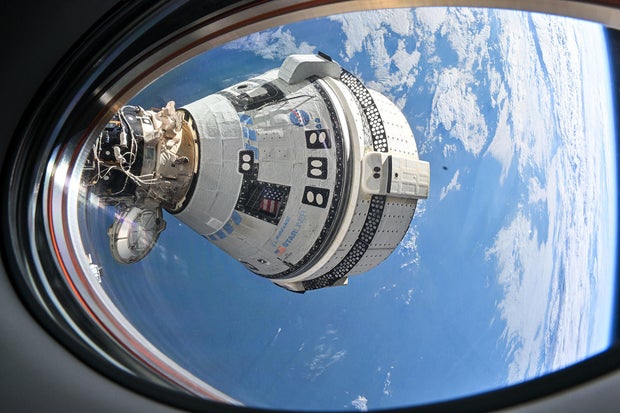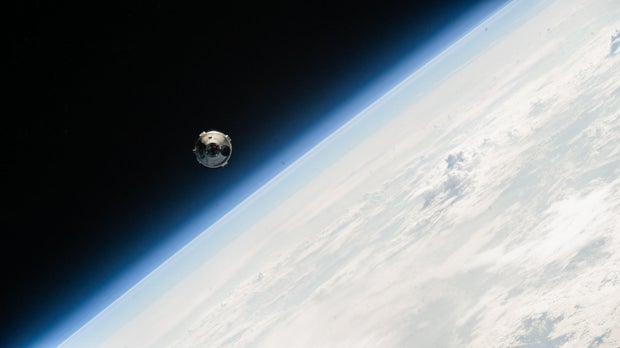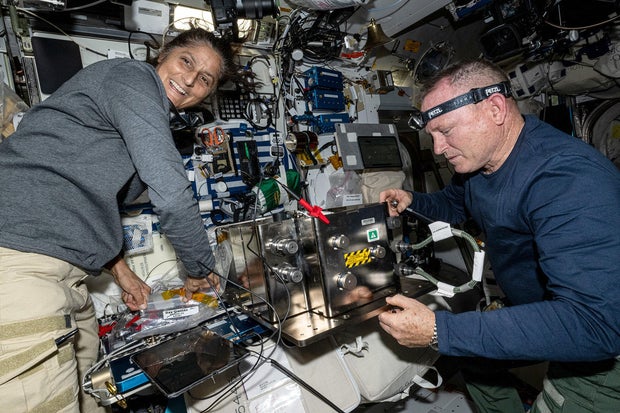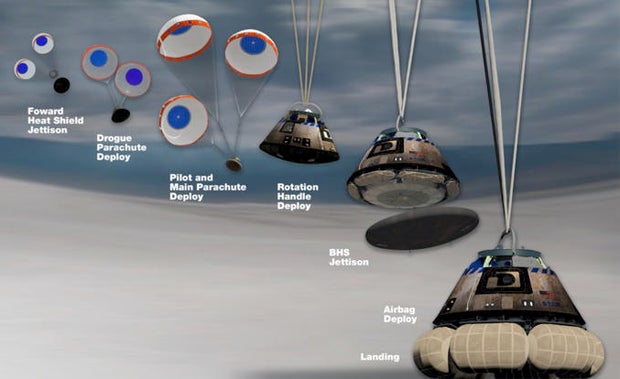CBS News
Boeing’s troubled Starliner, leaving its crew behind, set for unpiloted return to Earth
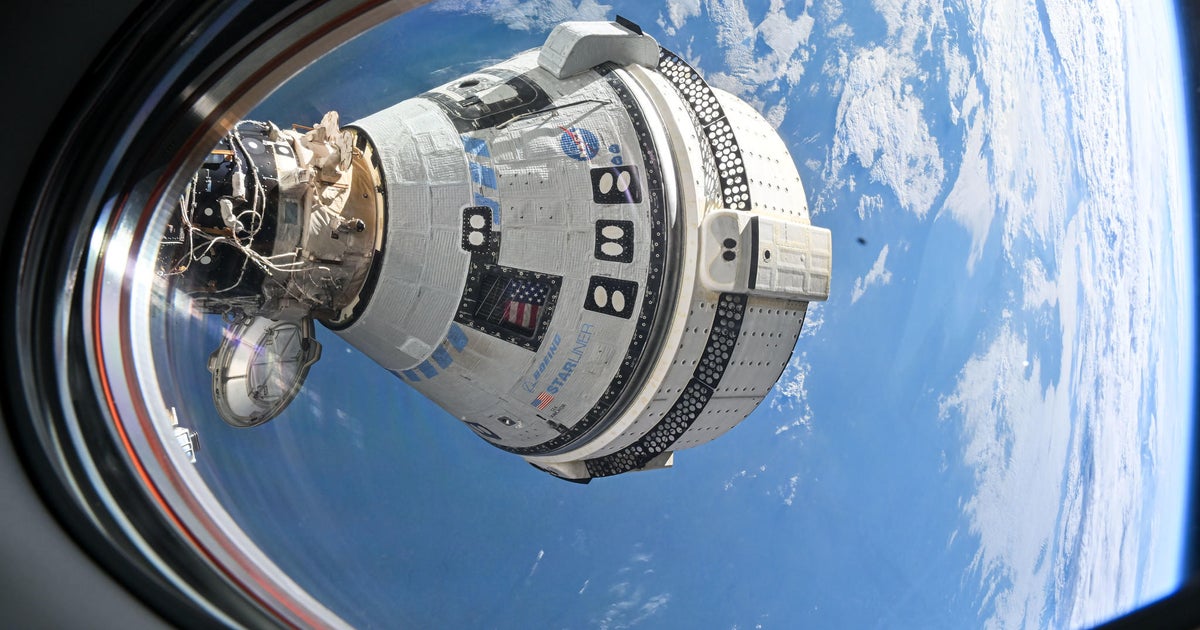
Boeing’s troubled Starliner spacecraft — not trusted by NASA to safely bring its crew home from the International Space Station — was rigged for undocking Friday and an unpiloted return to Earth to close out a disappointing test flight marred by helium leaks and thruster problems.
Leaving Starliner commander Barry “Butch” Wilmore and pilot Sunita Williams behind, the Boeing spacecraft was expected to undock from the station’s forward port at 6:04 p.m. EDT.
NASA
Looping up over the station to a point well above and behind the lab complex, the Starliner’s braking rockets were expected to fire at 11:17 p.m. to drop the ship out of orbit, setting up a fiery re-entry plunge to landing at White Sands, New Mexico, just after midnight Eastern Time.
Despite test data that convinced Boeing engineers and managers the Starliner could safely bring its crew home despite its earlier problems, NASA managers concluded enough uncertainty remained to justify keeping Wilmore and Williams on board the station and to bring their ship down by remote control.
Astronauts to remain in space until February
The two astronauts will remain on the space station until late February, hitching a ride home aboard a SpaceX Crew Dragon spacecraft being readied for launch Sept. 24 to ferry the next long-duration crew to the lab.
The Crew Dragon normally launches with four crew members, but two NASA astronauts were bumped from the upcoming Crew 9 flight to free up seats for Wilmore and Williams. They’ll join Crew 9 commander Nick Hague and Russian cosmonaut Alexander Gorbunov for a normal six-month tour of duty.
By the time they return to Earth around Feb. 22, Wilmore and Williams, who originally expected to spend about eight days in orbit, will have logged more than eight-and-a-half months in space.
NASA
NASA astronaut Frank Rubio faced a similar dilemma in 2022 when his six-month stay aboard the station was extended to more than a full year because of problems with the Russian Soyuz spacecraft that carried him to orbit.
“I think going from six months to 12 months is tough, but it’s not as tough as going from eight days to eight months,” Rubio said in an interview with CBS News. Asked how Wilmore and Williams took the news of their extension, he said “they’re doing great.”
“Certainly, there’s a little part of you that’s disappointed,” he added. “It’s okay to acknowledge that. But you also can’t mope around for the entire time, right? … You just have to kind of dedicate and rededicate yourself to the mission.”
Series of setbacks for Boeing
The decision to bring the Starliner down without its crew was a morale-sapping blow to Boeing in the wake of earlier problems that delayed the Starliner’s first piloted flight by nearly four years, required a second unpiloted test flight and cost the company more than $1.5 billion above and beyond its NASA fixed-price contract.
The Starliner woes come on top of Boeing’s ongoing struggle to restore public confidence in the wake of two 737 Max 8 airliner crashes, a close call with an Alaska Airlines 737 flight that suffered a door plug blowout earlier this year and more recent problems with an upgraded version of the company’s long-haul 777 aircraft.
It’s not yet known what will be needed to correct the problems encountered on the latest Starliner flight, whether another costly test flight will be required or when the ship might be ready for active service ferrying astronauts to and from the station.
NASA
The station crew closed the Starliner’s hatch at 1:29 p.m. Thursday. The day before, as Williams worked inside the Starliner helping arrange return items to ensure the right balance and center of gravity, she described the moment as “bittersweet.”
“Thanks for backing us up, thanks for looking over our shoulder and making sure we’ve got everything in the right place,” she told flight controllers. “We want her to have a nice, soft landing in the desert.”
After a final check of the weather at the New Mexico landing site remained favorable, hooks in the Starliner’s docking mechanism were expected to disengage, allowing springs on the station side to push the uncrewed ferry ship away.
A series of thruster firings were planned to slowly push the spacecraft out in front of the lab complex before looping up and over the top and departing to the rear. Seven minutes after undocking, the Starliner was expected to exit a 1,300-foot-wide safety zone known as the “keep out sphere.”
Given the earlier thruster problems, NASA shortened the departure timeline to get the Starliner well away from the station as quickly as possible. Sixteen minutes after leaving the keep-out sphere, the spacecraft was expected to exit the larger “approach ellipsoid,” another safety zone around the ISS that measures 2.5 miles long and 1.2 miles wide.
From there, the ship’s flight computers were programmed to guide the spacecraft toward a precise point in space where braking rockets can fire to slow the ship, dropping it out of orbit and putting it on course for an overnight landing at White Sands.
To get out of orbit, four large orbital maneuvering and attitude control rockets — OMACs — were required to fire for 59 seconds, slowing the ship’s 17,100-mph velocity by nearly 300 mph. That’s just enough to drop the far side of the orbit into the atmosphere for re-entry and descent to the New Mexico landing site.
While the powerful OMAC braking rockets are firing, smaller reaction control system, or RCS, jets were expected to fire on computer command to keep the Starliner stable and pointed in the right direction.
Once the deorbit rocket firing is complete, the Starliner’s service module, housing the OMACs, 28 RCS jets, the helium tanks and other critical but no-longer-needed systems, will be jettisoned to burn up on the atmosphere.
NASA
The crew module, protected by a heat shield and equipped with 12 RCS jets of its own, then will begin its re-entry at an altitude of about 400,000 feet, enduring temperatures as high as 3,000 degrees Fahrenheit as plunges back into the discernible atmosphere at nearly five miles per second.
The southwest-to-northeast re-entry trajectory will carry the Starliner across the Baja Peninsula, the Gulf of California, northern Mexico and into New Mexico.
At an altitude of about 24,500 feet, two small drogue parachutes will unfurl, slowing and stabilizing the Starliner. About one minute later, at an altitude of 8,000 feet, three pilot parachutes will pull out the ship’s three 104-foot-wide main parachutes, slowing the decent to about 18 mph.
At an altitude of 2,500 feet, airbags will inflate to reduce landing impact forces to the equivalent of walking speed. Touchdown is expected one minute after midnight EDT (10:01 p.m. Friday local time).
The deorbit burn and computer-orchestrated attitude control system firings are crucial to getting out of orbit on the precise trajectory needed for a pinpoint landing. And all of those firings require pressurized helium to push propellants to healthy thrusters.
Boeing
During the Starliner’s rendezvous with the space station on June 6, the day after launch, five RCS jets were “deselected” by the flight computer because of degraded thrust. In addition, four helium leaks in the propulsion pressurization system were detected, adding to a small leak that was detected before launch.
After extensive tests and analyses, Boeing engineers concluded the helium leaks were the result of slightly degraded seals exposed to toxic propellants over an extended period. But even with the leaks, they said the Starliner had 10 times more helium on board than needed to get out of orbit.
The thruster problem, testing indicated, was caused by high temperatures that, in turn, caused internal Teflon seals to deform in poppet valves, restricting the flow of fuel.
The high temperatures, the engineers concluded, were largely the result of manual flight control tests that caused the jets to fire hundreds of times in rapid-fire fashion while the craft was oriented so those same jets were in direct sunlight for an extended period.
In test firings later in the mission the jets appeared to be working normally, indicating the seals had contracted back to, or near, their original shape.
Boeing argued manual flight tests would be ruled out for a piloted return to Earth, the craft would be oriented to minimize solar heating on the suspect jets and fewer firings would be needed in the absence of a rendezvous.
Boeing tried to convince their counterparts at NASA that the Starliner had plenty of margin and would bring Wilmore and Williams safely back to Earth.
But NASA managers did not accept Boeing’s “flight rationale” and opted to bring the Starliner down without its crew.
“Spaceflight is hard. The margins are thin. The space environment is not forgiving,” said Norm Knight, director of flight operations at the Johnson Space Center. “And we have to be right.”
CBS News
Inside the threats against Springfield, Ohio, amid false Trump and Vance claims about immigrants

Watch CBS News
Be the first to know
Get browser notifications for breaking news, live events, and exclusive reporting.
CBS News
Will mortgage interest rates drop this week? Here’s what to know

Getty Images
Something that hasn’t happened since March 2020 is likely to occur this week – the Federal Reserve will issue a rate cut. With its federal funds rate frozen at a range between 5.25% and 5.50%, the highest in decades, the Fed is poised to issue its first reduction in years, likely by 25 basis points. But additional cuts could come later this year with the Fed set to meet two more times before the end of 2024.
The last time the Fed issued a cut was during the height of the pandemic and rates on borrowing products plummeted as a result. So does that mean that mortgage interest rates, already down by more than a point since 2023, will drop this week, too? Not necessarily. Below, we’ll break down what homebuyers should know now.
Start by seeing how low of a mortgage interest rate you could secure here.
Will mortgage interest rates drop this week?
The short answer to this question is “maybe.” The longer answer depends on a series of considerations that will vary based on the lender in question. That’s because this week’s presumed fed rate cut may have already been “priced in” by the bank or lender you’re planning on using. So the rate that’s listed on the lender website today, for example, may not be materially different than what’s offered after a formal cut is issued on September 18. How much each bank has priced in this week’s cut, however, will vary.
But mortgage interest rates don’t just follow the Fed’s monetary policy, even though they’re greatly influenced by it. They also track alongside the rate on the 10-year Treasury yield. Mortgage interest rates tend to follow that direction, going up or down as the yield does. This relationship exists because mortgages and 10-year Treasuries are competing long-term investments in the bond market.
When the 10-year Treasury yield rises, it typically indicates higher investor confidence in the economy and potentially higher inflation expectations. This leads investors to demand higher returns on mortgage-backed securities, causing lenders to increase mortgage rates. When the 10-year Treasury yield falls, mortgage rates tend to decrease as well. This correlation means that even if the Fed keeps its policy rate steady, changes in the 10-year Treasury yield can cause mortgage rates to fluctuate.
And remember that the best mortgage interest rates and terms will always be reserved for borrowers with clean credit histories and high credit scores. So even if rates do fall again later this week, you won’t be able to take advantage if your credit profile isn’t as attractive as lenders want it to be. The rates listed on lender websites, for example, are for those with excellent credit scores. And some will also list their offers with mortgage points already tacked on, making them appear lower than they would be if you didn’t pay that fee to score the lower rate. It’s critical, then, to monitor mortgage rates daily right now and to pay close attention to the fine print to make sure that what’s being advertised is available to a lender with your unique profile.
Start checking mortgage rates online today.
Don’t forget the cumulative effect
Even if mortgage interest rates fall directly in proportion to the federal funds rate — which is unlikely to happen — that reduction will only be by 25 basis points, if the predictions for this week’s rate cut hold true. That will just offer marginal relief to buyers. But don’t forget the cumulative effect of rate cuts. If the federal funds rate is reduced by that same amount when the Fed meets in November and again by the same amount when they meet in December, buyers could be positioned to see significant relief in their rate offers this year. And other possible cuts in 2025 could make it even more affordable to borrow money.
But mortgage rate cuts will inevitably complicate the homebuying process too, likely leading to higher home prices and steeper competition amid buyers that had previously been sitting on the sidelines. So prospective buyers will need to carefully weigh upcoming changes to the rate climate versus acting now to determine which is the most cost-effective approach for their situation.
The bottom line
Yes, mortgage interest rates may drop again this week but, more likely, most of today’s offers have preemptively reflected that cut. But with multiple rate cuts being discussed for the months ahead, the cumulative effect on mortgage interest rates is likely to be substantive. So it’s critical to consider what the homebuying market could look like then versus the benefits of acting now to better determine your best approach.
Learn more about today’s mortgage interest rates here.
CBS News
Assessing Secret Service’s response to latest apparent Trump assassination attempt

Watch CBS News
Be the first to know
Get browser notifications for breaking news, live events, and exclusive reporting.


